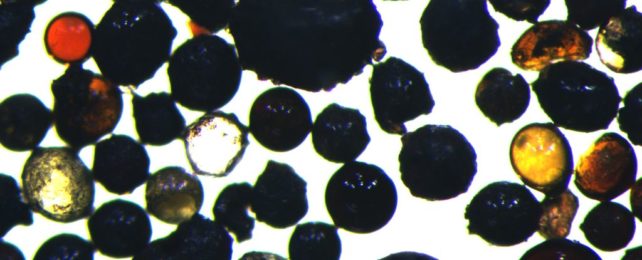Microscopic fragments of glass from the Moon have revealed a history of lunar impacts that lines up precisely with meteorite impacts here on Earth – including the giant asteroid impact 66 million years ago that killed most life on Earth and wiped out the dinosaurs.
Using a range of techniques, a team of scientists precisely traced 135 tiny glass beads, ferried back to Earth for the Chinese National Space Agency's Chang'e-5 sample return mission, to the time of their formation.
The results could shed new light on impact events that changed our world.
"We found that some of the age groups of the lunar glass beads coincide precisely with the ages of some of the largest terrestrial impact crater events, including the Chicxulub impact crater responsible for the dinosaur extinction event," says geologist Alexander Nemchin of Curtin University in Australia.
The study also suggests that large impact events on Earth, such as the Chicxulub asteroid that ended the dinosaurs' reign, could have been accompanied by several smaller impacts.
"If this is correct," says Nemchin, "it suggests that the age-frequency distributions of impacts on the Moon might provide valuable information about the impacts on the Earth or inner Solar System."
An asteroid or meteorite impact can be a tremendously energetic event, often generating great deals of heat. If silicate material is present – which it is, on both Earth and the Moon – this heat can cause melting and reformation found later in the form of tiny glass beads, called impact spherules.
There are also many other types of materials on the Moon besides silicates, and sometimes these other materials can get bound up in impact spherules in large enough quantities that we can analyze them.
This means that if scientists get their hands on some of these spherules, they can study them to learn more about how, when, and the environment in which they formed. The Chang'e-5 lunar sample return mission offered an opportunity to do just that.
A team led by geologist Tao Long of the Chinese Academy of Geological Sciences in Beijing isolated 215 spherules, ranging in size from 50 to 200 micrometers, from some of the soil Chang'e-5 collected and set about conducting their analysis.
Some of the spherules didn't contain enough additional material to allow for a detailed study. On the remaining 135, researchers conducted various tests to obtain chemical compositions and lead-uranium to determine their age.
This is a technique based on the radioactive decay of uranium into lead. Since we know how long uranium takes to decay, the relative amounts of uranium and lead in a sample can give us an estimate of the sample's age.
"We combined a wide range of microscopic analytical techniques, numerical modeling, and geological surveys to determine how these microscopic glass beads from the Moon were formed and when," Nemchin says.
The results show that the spherules were mostly local in origin, from the region around the Chang'e-5 lander. However, simulations suggest they can be flung around 100 kilometers (62 miles) from the impact site.
These simulations also suggest that the spherules also formed mainly in impacts that left craters between 100 and 1,300 meters (328 to 4,265 feet) in diameter. This information allowed the team to tentatively identify craters from the region in which they may have formed.
In age, the spherules ranged between a few million and 2 billion years old – that upper range was when the basin in which Chang'e-5 landed was resurfaced with fresh volcanic basalt. Of particular interest were spherules dated to 68 and 34 million years ago. The former coincides with the Chicxulub event; the latter with a smattering of craters from the late Eocene.
Although it could be a coincidence, the parallel timing suggests that the origin point of these events – possibly a smash-up in the asteroid belt – could have produced many rocks that simultaneously hit Earth and the Moon. This could give us new insight into how these impactors form and evolve and the dynamical processes within the asteroid belt.
"The next step," says planetary scientist Katarina Miljkovic of Curtin University, "would be to compare the data gleaned from these Chang'e-5 samples with other lunar soils and crater ages to be able to uncover other significant Moon-wide impact events which might, in turn, reveal new evidence about what impacts may have affected life on Earth."
The research was published in Science Advances.
